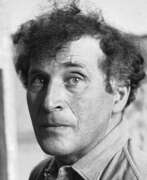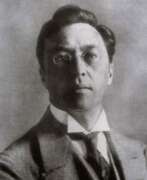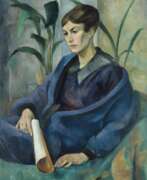Russia Degenerate art


Marc Chagall (Russian: Марк Заха́рович Шага́л), born Moishe Shagal in 1887 near Vitebsk, Belarus (then part of the Russian Empire), was a Belarusian and French artist celebrated for his pivotal role in the avant-garde movement and his unique integration of Eastern European Jewish culture into modern art. His contributions spanned several artistic formats including painting, stained glass, stage sets, ceramics, tapestries, and fine art prints. Chagall's early modernist tendencies were enriched by his experiences across Saint Petersburg, Paris, and Berlin before World War I, leading to a distinctive style that melded Cubism, Symbolism, and Fauvism with his Jewish heritage.
Chagall's work is recognized for its emotional depth, often exploring themes of love, memory, and Jewish folklore through vibrant colors and dreamlike imagery. Notably, art critic Robert Hughes described him as "the quintessential Jewish artist of the twentieth century," a sentiment echoed by art historian Michael J. Lewis who regarded Chagall as a significant figure within European modernism and as the world's preeminent Jewish artist of his time.
Among Chagall's famed contributions are his stained-glass windows for the cathedrals of Reims and Metz, the UN, and the Jerusalem Windows in Israel. His monumental paintings include parts of the ceiling of the Paris Opéra and works that explore biblical themes, a hallmark of his oeuvre that underscores his enduring engagement with spiritual and religious motifs.
For art collectors and antiques experts, Chagall's works are notable not only for their artistic innovation but also for their rich cultural and historical significance. His art is housed in many prestigious museums worldwide, including the Marc Chagall National Museum in Nice, France, which focuses on his works inspired by religion and houses the series of paintings illustrating the biblical message.
For those interested in exploring Chagall's legacy and the vibrant intersection of culture, art, and history his work represents, signing up for updates on new product sales and auction events related to Marc Chagall can provide invaluable insights and opportunities. This is an invitation to engage more deeply with the world of art and culture that Chagall so uniquely encapsulated in his work.


Wassily Wassilyevich Kandinsky (Russian: Василий Васильевич Кандинский) was a trailblazer in the art world, known for his pioneering role in the development of abstract art. Born in Moscow, Russia, in 1866, Kandinsky embarked on a journey that would take him from the study of law and economics to becoming one of the most influential artists of his time. His journey into the arts began at 30, a significant shift from a promising career in law to attending the Academy of Fine Arts in Munich. This decision marked the start of a profound exploration of color, form, and the spiritual in art.
Kandinsky's work is celebrated for its innovative use of color and abstract forms, with notable pieces such as "Composition VII" and "On White II" showcasing his ability to evoke emotional resonance through non-representational means. His art was not just about visual aesthetics but also aimed to touch the spiritual and emotional realms of the viewer. He often compared his method of painting to composing music, emphasizing the emotional power of abstract forms and colors. This philosophy was reflected in his theoretical writings, notably in "Concerning the Spiritual in Art," where he laid out his beliefs about the role of art and the artist in society.
Throughout his career, Kandinsky was involved with several avant-garde groups, including Der Blaue Reiter and Die Blaue Vier, collaborating with other influential artists of the time like Paul Klee and Alexej Jawlensky. After the Bauhaus school, where he taught, was closed by the Nazis, Kandinsky moved to France, where he spent the remainder of his life, continuing to evolve his style and contribute to the art world until his death in Neuilly-sur-Seine in 1944.
Kandinsky's legacy is not only in his artworks, which are held in esteemed collections worldwide, such as the Solomon R. Guggenheim Museum in New York, but also in his impact on the course of modern art. He opened up new possibilities for artists by demonstrating that art could venture beyond the representational and delve into the purely abstract, exploring the inner emotional and spiritual life through form and color.
For those captivated by Kandinsky's revolutionary approach to art and interested in the evolution of abstract expression, signing up for updates on new product sales and auction events related to Kandinsky's work is an excellent way to stay informed. This subscription service is tailored for collectors and art experts, ensuring you are the first to know about opportunities to acquire pieces by or related to this groundbreaking artist.


Lazar Markovich Lissitzky (Russian: Ла́зарь Ма́ркович Лиси́цкий) was a pivotal figure in the avant-garde art movement of the early 20th century, whose contributions spanned across multiple disciplines including painting, architecture, and graphic design. Born in Pochinok, Russian Empire (now in Smolensk Oblast, Russia), Lissitzky is renowned for his profound influence on the development of Constructivism, a movement characterized by the integration of technology and industry into the arts.
Lissitzky's work is distinguished by its innovative use of geometric forms, bold colors, and dynamic compositions, which sought not only to reflect the modern industrial world but also to actively participate in shaping it. His artworks and theories were instrumental in bridging the gap between the avant-garde movements in Russia and Western Europe, facilitating a cross-cultural exchange that enriched the development of modern art. Among his most notable contributions are his "Proun" series, an acronym for "Project for the Affirmation of the New" in Russian, which encapsulates his vision of art as a transformative social force.
His legacy is preserved in some of the world's most prestigious museums and galleries, including the Museum of Modern Art in New York and the Russian State Museum in Saint Petersburg. These institutions house key works that exemplify Lissitzky's groundbreaking approach to art and design, making them a focal point for collectors and experts in the field of art and antiques.
For those deeply invested in the evolution of modern art and its profound impact on culture and society, Lissitzky's work offers invaluable insights into the creative exploration of form and space. His contributions continue to inspire contemporary artists and designers, emphasizing the enduring relevance of his vision.
We invite collectors and art experts to sign up for updates on new product sales and auction events related to Lazar Markovich Lissitzky. This subscription is an opportunity to stay informed about the latest acquisitions and offerings that celebrate the legacy of a visionary artist whose work continues to resonate with audiences worldwide.


Aleksandra Andreevna Povorina (Russian: Александра Андреевна Поворина), married Ahlers-Hestermann, was a Russian and German modernist painter.
Aleksandra was born in the family of a St. Petersburg civil servant, in 1913 she went to Paris, where she studied at the Russian Academy of M. Vasilieva, joined the circle of artists of the Paris School, became interested in the art of Cézanne and Matisse. In Paris she met the artist from Hamburg Friedrich Ahlers-Hestermann (1883-1973), who became her husband. With the outbreak of World War I, the family moved to Hamburg.
Since 1915 the artist created semi-abstract paintings, participated in group exhibitions at the Commeter Gallery, was a member of the newly created Hamburg Secession with her husband. Under the influence of Paul Cézanne and Henri Matisse, she developed a spiritual-abstract art.
In 1934, the National Socialists who came to power in Germany banned Aleksandra and Friedrich any activity, and abstract paintings Povorina were recognized as degenerate. At that time the artist took up textile design, creating abstract patterns for fabrics, at the same time a series of black and white graphic ink drawings were created. During the war, many of the artist's works were destroyed.
After the end of World War II, Aleksandra took a teaching position at the Weissensee Higher Art School in Berlin, creating abstract collages. After her death, her daughter, textile, mosaic and glass artist Tatjana Ahlers-Hestermann, completed some of her works.


Alexej Georgewitsch von Jawlensky (Russian: Алексе́й Гео́ргиевич Явле́нский), a prominent Russian painter active in Germany, is renowned for his significant contributions to the Expressionist movement. Born in Russia in 1864, Jawlensky's artistic journey led him to Germany, where his career flourished alongside contemporaries such as Wassily Kandinsky. His work is celebrated for its vibrant use of color and emotional depth, qualities that have established him as a key figure in modern art.
Jawlensky's art evolved through various phases, from early landscapes and portraits to his later, more abstract works. Perhaps most notable among these are his "Mystical Heads" and "Saviour's Faces" series, inspired by the spiritual iconography of his Russian heritage, and his "Abstract Heads," where he explored the synthesis of spiritual expression and modernist aesthetics. These series reflect Jawlensky's lifelong quest to capture the soul's essence through the human face, a theme that resonates throughout his oeuvre.
His legacy extends beyond his artistic output; Jawlensky's influence is evident in the formation of The Blue Four, a group that played a crucial role in promoting modern art in Europe and the United States. Despite facing severe arthritis in his later years, which eventually halted his ability to paint, Jawlensky's dedication to his craft remained unwavering. He dictated his memoirs, ensuring his artistic philosophies and insights were preserved for future generations.
Jawlensky's works are held in high esteem and are featured in prestigious collections worldwide, including the Museum Wiesbaden, which boasts the most extensive collection of his works in Europe. His contributions to art have been recognized posthumously through significant sales at auction and the establishment of the Jawlensky Award, which honors contemporary artists' achievements in his memory.
For collectors and art and antiques experts, Jawlensky's work offers a profound insight into the evolution of Expressionism and the enduring power of the visual arts to convey deep emotional and spiritual truths. His life and work continue to inspire and influence, a testament to his significant impact on the art world.
For those interested in exploring the depths of Expressionist art and the legacy of Alexej Georgewitsch von Jawlensky, staying informed about upcoming sales and auction events related to his work is invaluable. Signing up for updates can provide access to the latest opportunities to engage with his impactful and beautiful creations.